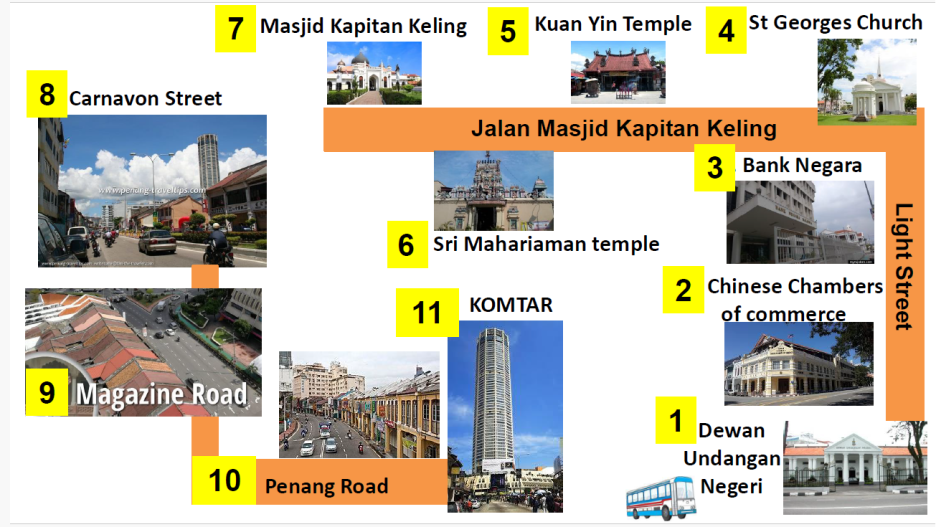Dewan Undangan Negeri: The Legislative Hub
The Penang State Legislative Assembly, housed in the Dewan Undangan Negeri, comprises 40 elected lawmakers shaping the state’s policies. Under the leadership of the current Chief Minister, The Right Honourable Mr. Chow Kon Yeow, this assembly serves as the democratic nucleus, steering Penang’s future course.
Chinese Chamber of Commerce: Pioneers in Trade Advocacy
Established in 1903, the Chinese Chamber of Commerce stands as one of the pioneer trade organizations in the region. Known for its influential role, it made history by leading a protest in 1946 to restore Penang’s free port status. This act showcased the chamber’s commitment to the economic well-being of the region. Recognized by both public and private sectors, the chamber remains a formidable commercial institution, actively contributing to the economic vibrancy of Penang.
Bank Negara: The Financial Backbone
Bank Negara, as the central bank of Malaysia, plays a crucial role in the nation’s financial landscape. Beyond issuing currency, it acts as the banker and adviser to the government of Malaysia. Regulating the country’s financial institutions, Bank Negara ensures the stability and integrity of the financial system. Its multifaceted responsibilities underscore its significance as the financial backbone, supporting Malaysia’s economic growth and development.
St George’s Church: An Emblem of Colonial Legacy
St George’s Church, an Anglican masterpiece erected in 1818 on Farquhar Street, stands as a testament to Penang’s historical tapestry. Originally commissioned to meet the spiritual needs of the British colonial administration, the church bore witness to the turbulent pages of Malayan history during the Japanese Occupation. Ravaged by the conflict, the resilient structure underwent restoration in 1948, symbolizing the indomitable spirit of both the church and the community it served.
Kuan Yin Temple: Harmony Amidst Diversity
Built in 1728, Kuan Yin Temple is the oldest Buddhist temple in Penang. Dedicated to the Goddess of Mercy, Guan Yin, the temple played a crucial role in mediating conflicts between the rival Cantonese and Hokkien communities. Adorned with gigantic doors featuring paintings of Taoist and Buddhist deities, the temple stands as a testament to the cultural harmony fostered within its walls.
Sri Mahariaman Temple: A Sacred Haven
Constructed in 1833, Sri Mahariaman Temple holds the distinction of being the oldest Hindu temple in the state. Featuring intricate sculptures of gods and goddesses, the temple, dedicated to Mariamman, the goddess of disease, rain, and protection, is a spiritual haven. The annual Thaipusam celebration, marked by a golden chariot’s journey from Queen Street to Sri Ganesha Temple, adds a vibrant cultural touch to the temple’s significance.
Masjid Kapitan Keling: A Monument to Diversity
Founded by Cauder Mohudeen, a prominent Indian Muslim leader, Masjid Kapitan Keling stands as a testament to Penang’s religious diversity. Cauder Mohudeen, often referred to as ‘Kapitan Kling,’ was granted land to build the mosque, reflecting the inclusive and harmonious coexistence of different communities in Penang.
Carnarvan Street: Echoes of History and Commerce
Named after the 4th Earl of Carnarvon, Henry Howard, Carnarvan Street has witnessed historical events, including riots between Cantonese and Hokkiens in 1867. Evolving into a hub for bookshops and coffin makers in the mid-20th century, Carnarvan Street reflects the fusion of history and commerce that defines Penang’s unique character.
Magazine Road: A Road with Explosive Origins
Magazine Road, one of the busiest in the city, derived its name from a gunpowder depot situated where the present GAMA Supermarket stands. Known as Thau Taiu Lo, implying that Magazine Road is the first street within the 7 Streets Precinct, it serves as a dynamic artery in Penang’s urban landscape.
Penang Road: A Culinary and Cultural Thoroughfare
Penang Road, a one-way street stretching from Farquhar Road to KOMTAR, encapsulates the essence of Penang’s vibrant culture. Home to the bustling Chowrasta Market, renowned for its wide variety of raw, processed, and packed foods, Penang Road is a culinary and cultural thoroughfare that reflects the city’s bustling energy.
KOMTAR: A Modern Icon with Historical Significance
KOMTAR, standing at 232 meters, not only serves as a towering architectural landmark but also houses the Penang Island City Council, government offices, and the Chief Minister of Penang’s office. In 2016, a transformative program known as “The Top” reconstructed the top floors, featuring a viewing deck named “Window on The Top.” KOMTAR, thus, represents a convergence of modernity and historical significance in Penang’s skyline.
